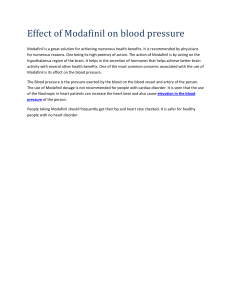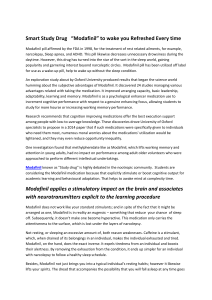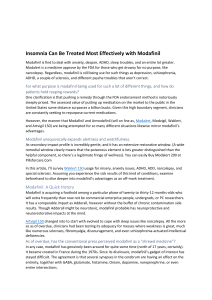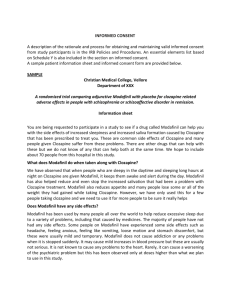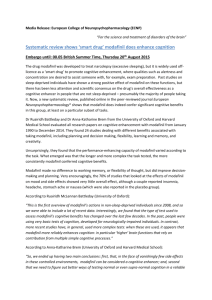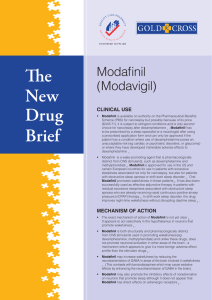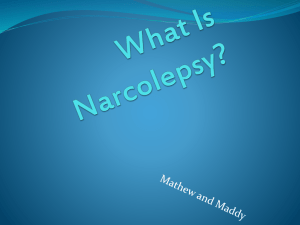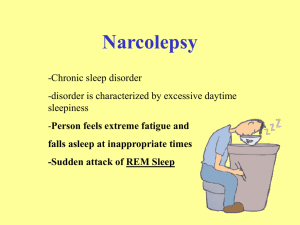PPT
advertisement
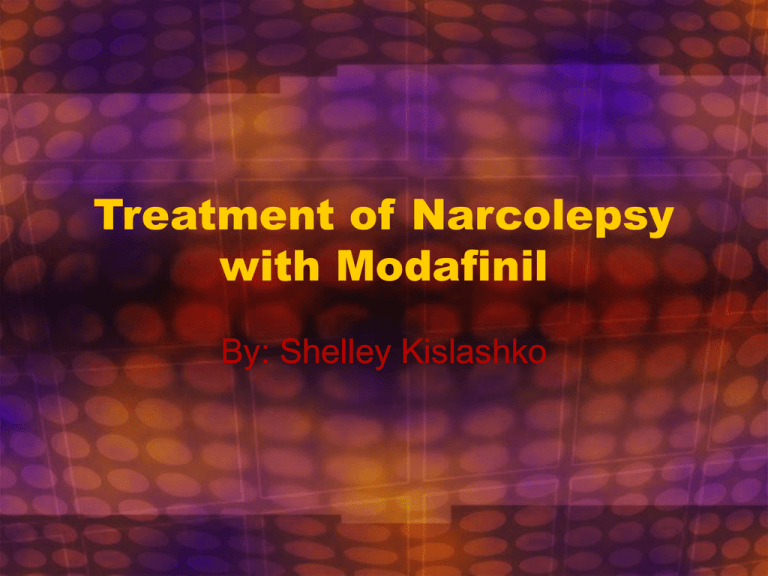
Treatment of Narcolepsy with Modafinil By: Shelley Kislashko History of Treatment for Narcolepsy • 1st drug used to treat narcolepsy was ephedrine in 1931. Followed by the amphetamines. • In 1959, methylphenidate was introduced and extensive use proceeded. • Modafinil originated in the late 1970’s and approved by the U.S. Food and Drug administration in 1998 for administration. • Modafinil is now one of the most widely used treatment options for Narcolepsy. Neurobiology of Narcolepsy • Genetic factors appear to play an important role in the development of narcolepsy. These genetic factors also appear to vary with ethnicity. • More commonly narcolepsy is an acquired disease often from various head trauma situations. • Orexin plays a critical role in the neurobiology of narcolepsy. Orexin-containing neurons are found only in the posterior and lateral hypothalamus, but they project widely throughout the CNS, innervating the aminergic and cholinergic regions that promote wakefulness. Currently, it is only partially known which regions are necessary for the wake-promoting effects of orexin. Neurobiology of Narcolepsy ~ Cont’d • Gradual failure to produce orexin has been discovered and researches have proposed that an autoimmine or neurodegerative process could cause the selective loss. • Dopaminergic signaling also may promote wakefulness. It has been researched that lesions of dopaminergic cells in the ventral midbrain can reduce wakefulness. Mechanism of Action for Modafinil • The precise mechanism through which modafinil promotes wakefulness is unknown. • Early work on modafinil suggested action through alphaadrenergic receptors, but modafinil does not bind to alphareceptors, or other receptors or reuptake site for noradrenaline, GABA, benzodiazepines, or adenosine. • Modafinil can reduce the extra cellular concentrations of GABA, and this decrease in GABA may disinhibit specific wake promoting systems. • Modafinil may increase dopaminergic signaling by weakly binding to the dopamine reuptake transporter. Case Study • “A randomized trail of the long-term, continued efficacy and safety of modafinil in narcolepsy” – By: Moldofsky, Broughton and Hill • Objective: To assess the continued efficacy of modafinil in the treatment of narcolepsy. • Method: 69 patients with narcolepsy continued on modafinil for 16 weeks of open-label treatment. Followed by 2 weeks where patients were randomly and blindly allocated to continue modafinil at the same dose or placebo. Case Study • Results: Mean dose of 330 mg of modafinil continued to produce a significant decrease in EDS as measured. Modafinil had no significant effects on nocturnal sleep, blood pressure, heart rate, the ECG, weight, or mood. • Conclusions: Modafinil continues to be an effective and well-tolerated drug after 16 weeks of treatment. • Limitations: Small population size, of 69 only 63 completed the full 16 week study. Pharmacokinetics • Modafinil is a racemic compound whose enantiomers do not interconvert. The effective elimination half-life of modafinil is about 15 hours. • Absorption of the tablet is rapid, with peak plasma concentrations occurring at 2-4 hours. • Food has no effect on overall bioavailability, however, its absorption may be delayed approximately one hour if taken with food. • The major route of eliminations is metabolisms (~90%), primarily by the liver, with subsequent renal elimination of the metabolites. • The recommended dose is 200 mg taken as a single dose in the morning. Drug Interactions • Co-administration of modafinil with drugs such as diazepam, phenytoin and propranolol may increase the circulating levels of those compounds and dose adjustments maybe necessary. • Co-administration of modafinil with other CNS active drugs such as methylphenidate and dextroamphetamine did not significantly alter the pharmacokinetics of either drug. Tolerability, Safety and Abuse Potential • Generally well tolerated with the commonest symptoms occurring include headache, nausea, hyperactivity, dry mouth, palpitations and insomnia. • Abuse potential: modafinil is listed in Schedule IV of the Controlled Substances Act, stating that the substance has low potential for abuse. • Overdose may lead to experiences of excitation or agitation, and insomnia. • No specific withdrawal symptoms have been recorded based on clinical trials although sleepiness is returned in narcoleptic patients. Comparison of Amphetamines and Modafinil Advantages of Treatment with Modafinil • Modafinil increases wakefulness without causing autonomic arousal and psychostimulant agitations as sympathomimetic drugs do. • Amphetamines cause the release of noradrenaline, which leads to enhance sympathetic activity that may cause intolerable side effects. • Amphetamines have a higher risk for abuse, tolerance and unfavorable withdrawal symptoms, unlike modafinil. • The half like of methylphenidate is 3-4 hours as compared to 15hours for modafinil. Disadvantages for Treatment with Modafinil • Few long-term studies have been conducted on modafinil but show inconsistency regarding efficacy or possible unfavorable effects. • Modafinil is not a cure for narcolepsy. Narcolepsy is a chronic disorder lasting a lifetime, and modafinil is required for long-term treatment. • Modafinil is not applicable for treatment with individuals under the age of 16 years. Future Research • Clinical trials are needed to compare sympathomimetic drugs with modafinil, in patients with narcolepsy, to determine efficaciousness in their wakefulness promotion and enhancement of cognitive function. • Long-term safety profile is necessary. • Continued research in the neurobiology of modafinil to fully understand the exact mechanisms of the agent as a wakefulness promoter. • Continued clinical trials are required to understand interactions with alcohol and other drugs. Future Research • Research has not been conducted to see if modafinil has potential use applicable to individuals under the age of 16 years. • With the discovery of orexin deficiency as a possible cause leading to narcolepsy, research is required to understand the reason for this depletion and the possible relationship with modafinil. Evaluation I feel when considering the advantages and disadvantages of modafinil in comparison to other treatment mechanisms, such as psychostimulants, modafinil appears to be a safer alternative route. There are less uncomfortable side affects; lesser risk of tolerance, abuse or withdrawal symptoms and thus this may provide greater reasons for patient compliance and overall satisfaction with the drug treatment. Modafinil achieves the same promising effects for treatment as other psychostimulants, minus the more adverse side effects. My concern towards the use of this drug treatment for narcolepsy is in regards to how new this treatment is and the lack of information on important on long-term use for the potential problems that could arise in the future. Since narcolepsy is a chronic illness modafinil would be required as a treatment for the length of ones life and if it is unknown whether serious side effects await a longtime user, administration of this drug keeps me skeptical.
